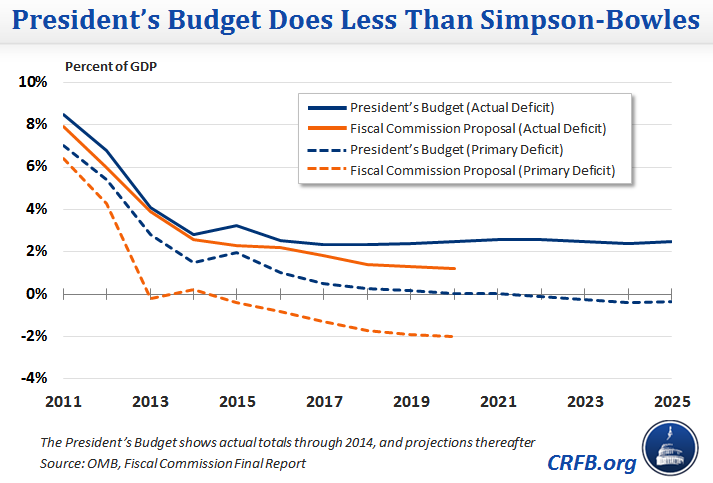No, the President's Budget Doesn't Meet Simpson-Bowles Targets
In touting the low deficits in the President's budget, White House Press Secretary Josh Earnest claimed that by reducing the deficit below 3 percent of GDP, the budget met fiscal targets set by the Simpson-Bowles Fiscal Commission. Yet neither the Commission nor Erskine Bowles or Al Simpson ever set any target like this – the White House did. In fact, the President's budget doesn't even meet that goal until seven years after the target date.
In a press conference on Monday, Earnest claimed :
The 3 percent target was also the one advocated by the minor deities that served on the Simpson-Bowles Commission. So it’s worth pointing out that while that certainly included the wisdom of the Obama economic team, it also included the stamp of approval from that bipartisan commission.
Yet Earnest fails to mention that this target was not set by the Fiscal Commission, but by President Obama when he created it. In establishing the Commission, the White House wrote that it should "make recommendations that put the budget in primary balance so that we are paying for all operations and programs for the federal government (achieving deficits of about 3 percent of GDP) by 2015 and meaningfully improve the long-term fiscal outlook."
The Fiscal Commission clearly viewed this target as inadequate, particularly over the long-run. In its report, the commission noted that its plan would:
Reduce the deficit to 2.3% of GDP by 2015 (2.4% excluding Social Security reform), exceeding President’s goal of primary balance (about 3% of GDP)...Stabilize debt by 2014 and reduce debt to 60% of GDP by 2023 and 40% by 2035. [emphasis added]
Indeed, under the Fiscal Commission's projections, deficits would fall from 2.3 percent of GDP in 2015 to 1.2 percent by 2020, 0.8 percent by 2025, and 0 percent (a balanced budget) by 2035.
By comparison, the President's budget does not even meet the goal the White House set out for the Fiscal Commission – primary balance by 2015.
While the President's Budget keeps deficits below 3 percent of GDP throughout the next decade, the budget does not hit the executive order's stated goal – primary balance – until 2022. For 2016, the budget calls for a primary deficit (excluding interest) of 1 percent of GDP.
Admittedly, a lot has changed since the Commission's report in 2011 that might prolong deficits. The economic recovery has taken longer than anticipated. Troops spent more time in Iraq and Afghanistan than we had hoped. And there's been a technical change to the way that GDP is measured.
Still, it would be incorrect to argue that the budget ever reaches targets "advocated by the minor deities that served on the Simpson-Bowles Commission." At best, the budget reaches targets the White House itself set, but not until 2022.



